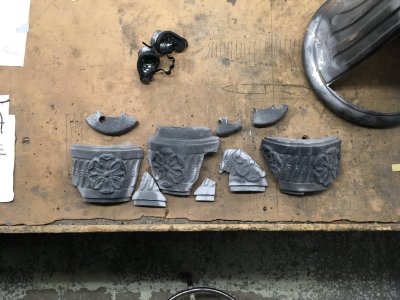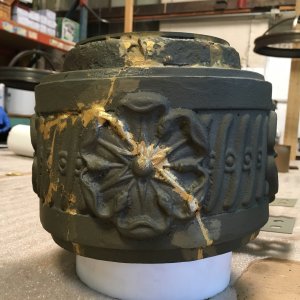grease monkey
just another day!
any tips/tricks to welding thin cast iron? I need to make 2 pulleys into one (long story)
any tips/tricks to welding thin cast iron? I need to make 2 pulleys into one (long story)
When repairing the gear box crack make sure to burn out all the oil from the crack before you start your repair. I usually give a good cleaning with a non chlorinated brake cleaner then heat the crack with a torch and burn out all the crap inside that you can't see. I'm sure it has been said on here before if you are going to weld something that you have cleaned with brake clean make absolutely sure it is non chlorinated! Chlorinated brake clean when heated produces chlorine gas the same type of stuff used in WWI trench warfare.Megar, thanks for your input! I did not know that about the fumes so that will be noted for sure. as far as alignment, a made a shaft that fits snugly through both bores and tapped holes in the ends to afford a touch of clamping force to keep them where I want them, the other issue is that the original pulley is keyed for balancing, so I've already talked to my race engine builder and he's going to balance them for me using the stock balance profile. I do also have a small 90 degree gearbox that suffered from frost jacking, its in a no pressure situation on the box, the crack only effects its ability to keep gear oil inside, so that crack I intend to drill crack end points, V grind a touch and weld, its also 1/8" thick, so I figure the same techniques will apply. Thank You all for the tips. I'll try to post some pics of both projects and results, which should be visible if I can take a pic properly!
He was right. I would use Ni-rod and weld 1" beads, and then peen while cooling. Peening swells the weld as cooling occurs to counter shrinkage that causes cracking. You should always be able to touch the work. When it gets too hot to do that walk away for a bit. I have welded tractor engine blocks with a 24" long crack in it this way. Modern cast is very weldable as it has a high nickel content compared to WW2 grey cast iron.ok, somehow my last message crapped out, fat fingered something wrong I guess! Ok, I'm repowering 2 classic lawn tractors, that would be me, lets not do one to prove concept, lets do 2 right away and a 3rd when ready! in this process, I'm pulling an Onan CCKB motor to install a Kubota 722 super mini diesel, the front crank pulley is cast, 4" dia, single groove, A series belt, what I need is a 2 groove B series pulley welded to it, as the original is splined internally, so I figure on welding my desired pully to the original, both are cast, both are thin, 1/8" or less, after speaking to my weld supplier, and him talking to his weld engineer, he says to use silicon bronze wire in my mig machine with straight argon, small convex stringer beads and use short passes and keep heat below 100 degree's! that kinda sounded off to me, which is why I'm reaching out, everyone is telling me preheat and slow cool, this guy is opposite, because of how thin the V's are, guess I better suit up and find out! picture of tractor in question....


As others have noted, I’ve also had best results with torch brazing. Have done some field work with nickel stick electrodes, and have done some tig brazing.
I still think of that one as ‘Humpty Dumpty’ .That repair is amazing!
You are a lucky man you know! Not many guys find a job they love. Those that do, never have to work.
